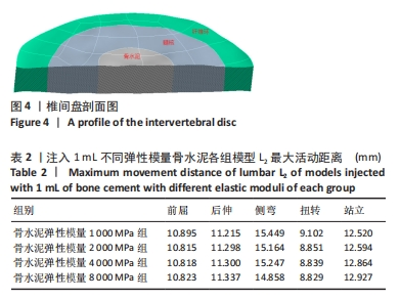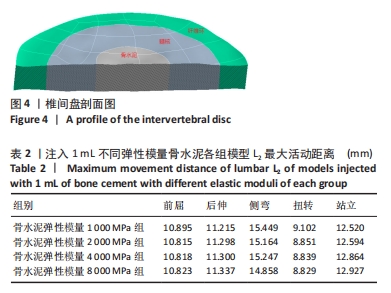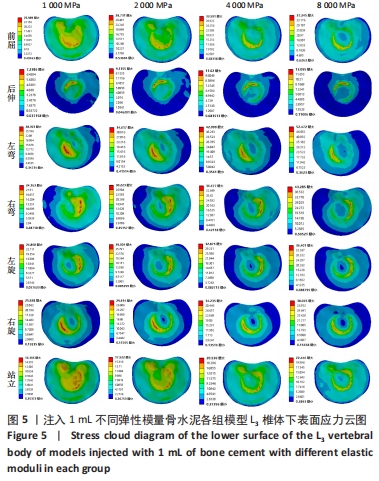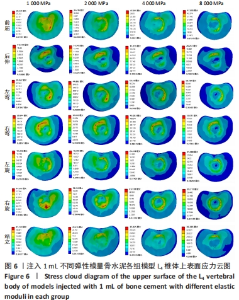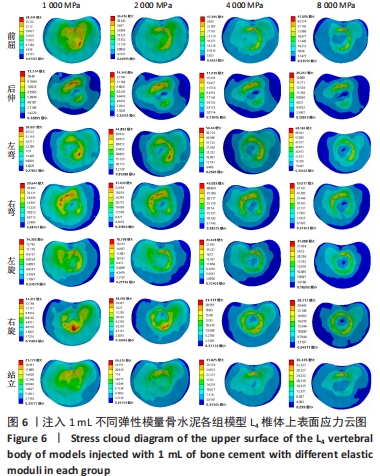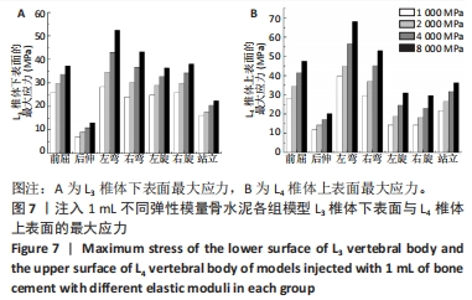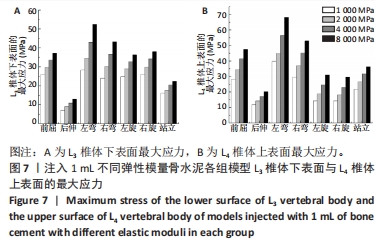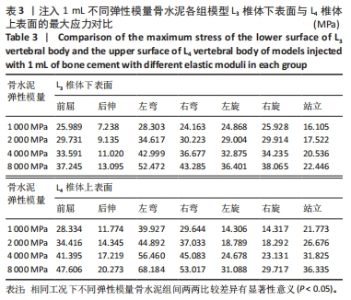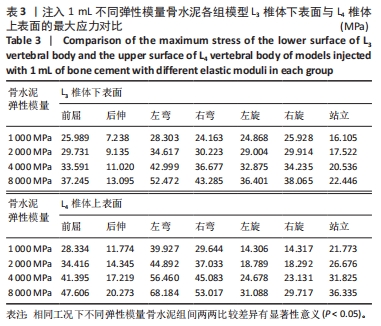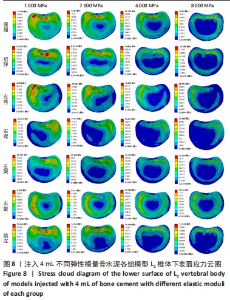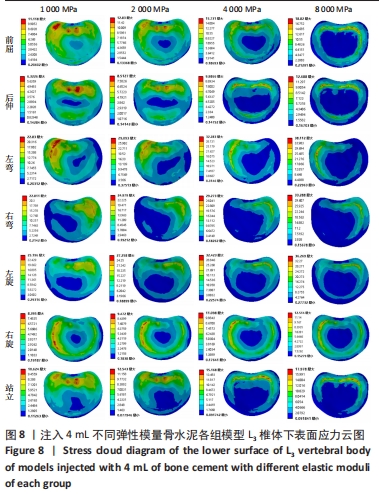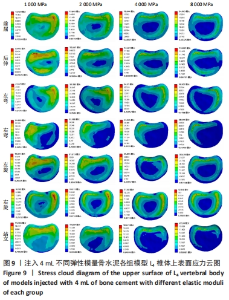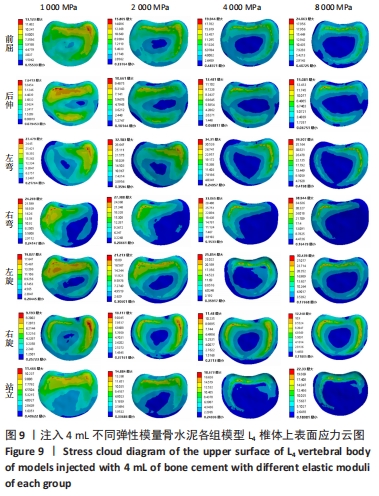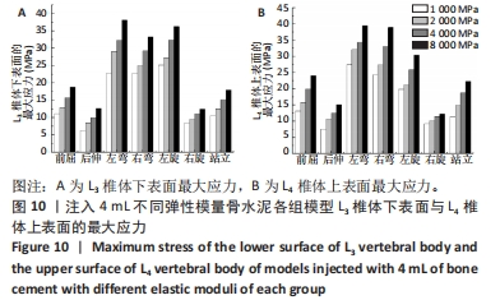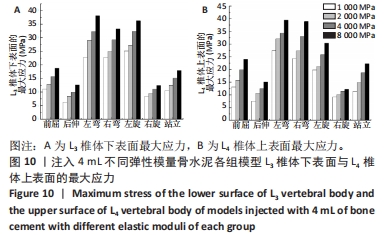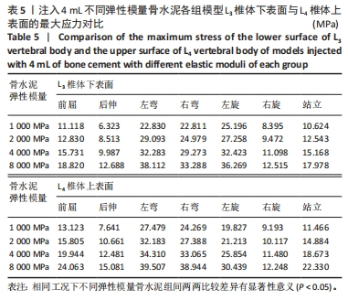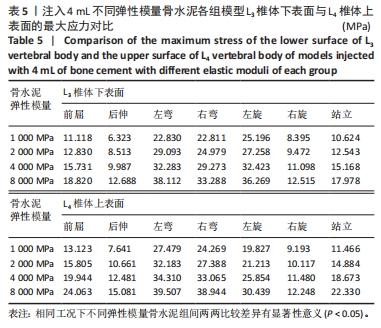Chinese Journal of Tissue Engineering Research ›› 2024, Vol. 28 ›› Issue (22): 3548-3554.doi: 10.12307/2024.527
Previous Articles Next Articles
Effect of bone cement with different elastic moduli injected into intervertebral space on stress of adjacent upper and lower vertebrae
Wang Jianxin1, Huo Wentao1, Yu Ze2
- 1Inner Mongolia University of Science and Technology, Baotou 014010, Inner Mongolia Autonomous Region, China; 2First Affiliated Hospital of Baotou Medical College, Inner Mongolia University of Science and Technology, Baotou 014017, Inner Mongolia Autonomous Region, China
-
Received:2023-09-12Accepted:2023-10-30Online:2024-08-08Published:2024-01-20 -
Contact:Huo Wentao, Master candidate, Inner Mongolia University of Science and Technology, Baotou 014010, Inner Mongolia Autonomous Region, China -
About author:Wang Jianxin, MD, Doctoral supervisor, Professor, Inner Mongolia University of Science and Technology, Baotou 014010, Inner Mongolia Autonomous Region, China -
Supported by:Natural Science Foundation of Inner Mongolia Autonomous Region, No. NJZY22091 (to YZ)
CLC Number:
Cite this article
Wang Jianxin, Huo Wentao, Yu Ze. Effect of bone cement with different elastic moduli injected into intervertebral space on stress of adjacent upper and lower vertebrae[J]. Chinese Journal of Tissue Engineering Research, 2024, 28(22): 3548-3554.
share this article
Add to citation manager EndNote|Reference Manager|ProCite|BibTeX|RefWorks
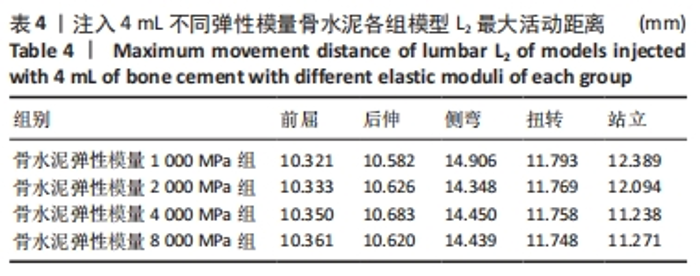
随着骨水泥弹性模量的增大,L3椎体下表面与L4椎体上表面的应力增加,其中弹性模量1 000 MPa骨水泥对L3椎体下表面与L4椎体上表面的应力影响最小,弹性模量8 000 MPa骨水泥对L3椎体下表面与L4椎体上表面的应力影响最大,相同工况下不同弹性模量骨水泥组间两两比较差异有显著性意义(P < 0.05)。 2.2 注入4 mL不同弹性模量骨水泥后邻近上下椎体表面的应力变化 为避免数据的偶然性,同时又建立了在椎间盘中注入4 mL不同弹性模量骨水泥的腰椎有限元模型,也同样模拟人体主要的7种活动情况。不同工况下各组模型腰椎活动度(侧弯为左弯和右弯的结果取平均值,扭转为左旋和右旋的结果取平均值)见表4,结果显示不同弹性模量骨水泥对整个腰椎活动度的影响较小。不同工况下各组模型L3椎体下表面与L4椎体上表面的应力云图,见图8,9。不同工况下各组模型L3椎体下表面与L4椎体上表面的最大应力,见图10,表5。"
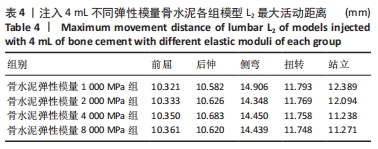
| [1] MAHER C, UNDERWOOD M, BUCHBINDER R. Non- specific low backpain. Lancet. 2017;389(10070):736-747. [2] VARGA PP, JAKAB G, BORS IB, et al. Experiences with PMMA cement as a stand-alone intervertebral spacer: Percutaneous cement discoplasty in the case of vacuum phenomenon within lumbar intervertebral discs. Orthopade. 2015;44 Suppl 1:S1-7. [3] KISS L, VARGA PP, SZOVERFI Z, et al. Indirectforaminal decompression and improvement in the lumbar alignment after percutaneous cement discoplasty. Eur Spine J. 2019;28(6):1441-1447. [4] 向刚刚,童猛,曹鹏,等.新型骨水泥研究进展[J].中国中医骨伤科杂志,2023,31(6):83-88. [5] SZCZĘSNY G, KOPEC M, POLITIS DJ, et al. A Review on Biomaterials for Orthopaedic Surgery and Traumatology: From Past to Present. Materials (Basel). 2022;15(10):3622. [6] GINEBRA MP, CANAL C, ESPANOL M, et al. Calcium phosphate cements as drug delivery materials. Adv Drug Deliv Rev. 2012;64(12):1090-1110. [7] XU H, ZHU L, TIAN F, et al. In vitro and in vivo evaluation of injectable strontium-modified calcium phosphatecement for bone defect repair in rats. Int J Mol Sci. 2022;24(1):568. [8] WELCH-PHILLIPS A, GIBBONS D, AHERN DP, et al. What Is Finite Element Analysis? Clin Spine Surg. 2020;33(8):323-324. [9] CAI XY, SANG D, YUCHI CX, et al. Using finite element analysis to determine effects of the motion loading method on facet joint forces after cervical disc degeneration. Comput Biol Med. 2020;116:103519. [10] BELYTSCHKO T, KULAK RF, SCHULTZ AB, et al. Finite element stress analysis of an intervertebral disc. J Biomech. 1974;7(3):277-285. [11] 方新果,赵改平,王晨曦,等.基于CT图像腰椎L4~L5节段有限元模型建立与分析[J].中国生物医学工程学报,2014,33(4):487-492. [12] 秦大平,张晓刚,聂文忠,等.不同运动状态下模拟人体腰椎结构特征变化的有限元分析[J].医用生物力学,2017,32(4):355-362. [13] 张敏,彭婧,张强,等.有限元法分析老年骨质疏松患者L_(3/4)椎板减压椎间融合的力学性能[J].中国组织工程研究,2024,28(6): 847-851. [14] 李嘉睿,燕杨,武晓刚,等.单边双通道内镜下腰椎椎间融合的生物力学分析[J].中国组织工程研究,2023,27(34):5523-5529. [15] 王智.基于CT数据L4-5有限元模型的构建以及L5的应力分析[D].太原:山西医科大学,2011 [16] 张涵.基于Abaqus椎体成形术生物力学有限元分析[D].遵义:遵义医学院,2018. [17] 李银倩,吕杰,丁立军,等.韧带损伤影响腰椎稳定性的生物力学特征[J].中国组织工程研究,2024,28(21):3286-3292. [18] MARKOLF KL. Deformation of the thoracolumbar intervertebral joints in response to external loads a biomechanical study using autopsy material.J Bone Joint Surg Am. 1972;54(3):511-533. [19] SCHULTZ AB, WARWICH DN, BERKSON MH, et al. Mechanical properties of human lumbar spine motion segments part 1:responses in flexion,extension,lateral bending,and torsion. J Biomech Eng. 1979;101: 46-52. [20] TENCER AF, AHMED AM, BURKE DL. Some static mechanical properties of the lumbar intervertebral joint: intact and injured. Biomech Eng. 1982;104(3):193-201. [21] WHITE AA, KRAG M, PANJABI MM, et al. Effect of preload on load displacement curves of the lumbar spine. Orthop Clin North AM. 1977;8(1):181-192. [22] 赵文韬,秦大平,张晓刚,等.功能复位椎体强化治疗骨质疏松性椎体压缩骨折的有限元分析[J].世界科学技术-中医药现代化, 2018,20(3):439-445. [23] 包拥政,祝周兴,冯云升,等.低弹性模量骨水泥对骨质疏松压缩性骨折椎体及邻近椎体应力的影响:三维有限元分析[J].中国组织工程研究,2016,20(16):2285-2293. [24] 刘鹤飞,田庆华,易飞,等.经皮骨水泥椎间融合术在椎体转移瘤治疗中的应用[J].介入放射学杂志,2019,28(5):459-464. [25] 王莹莹,杨寅,王义清,等.经皮骨水泥椎间盘成形术治疗顽固性腰痛1例[J].颈腰痛杂志,2020,41(2):256. [26] 田庆华,王涛,何煜,等.经皮骨水泥椎间融合术与骨水泥椎间盘成形术治疗老年腰椎间盘突出症的疗效比较[J].介入放射学杂志, 2021,30(3):264-269. [27] TECHENS C, PALANCA M, ELIES PE, et al. Testing the impact of discoplasty on the biomechanics of the intervertebral disc with simulatedde generation:Aninvitro study. Med Enphys. 2020;84:51-59. [28] 李爽,徐宝山,马信龙.经皮椎间盘骨水泥成形术的研究进展[J].中国矫形外科杂志,2021,29(21):1961-1964. [29] CAMINO WILLHUBER G, BENDERSKY M, DE CICCO FL, et al. Development of a New Therapy-OrientedClassification of Intervertebral Vacuum Phenomenon With Evaluation of Intra- andInterobserver Reliabilities. Global Spine J. 2021;11(4):480-487. [30] TECHENS C, PALANCA M, ÉLTES PE, et al. Testing the impact of discoplasty on the biomechanics of the intervertebral disc with simulated degeneration: An in vitro study. Med Eng Phys. 2020;84:51-59. [31] LAZARY A. Expert’s Comment concerning Grand Rounds Case entitled”Percutaneous cement discoplasty for the treatment of advanced degenerative disk disease in elderly patients” : (C. Sola, et al., Eur Spine J; 2018: DOI 10.107/s00586-018-5547-7). Eur Spine J. 2021;30(8):2209-2210. [32] KARAHALILOGLU Z, KILICAY E. In vitro evaluationof bone cements impregnated with selenium nanoparticlesstabilized by phosphatidylcholine (PC) for application inbone. J Biomater Appl. 2020;35(3):385-404. [33] SLANE J, VIVANCO J, ROSE W, et al. Mechanical, material,and antimicrobial properties of acrylic bone cementimpregnated with silver nanoparticles. Mater Sci Eng C Mater Biol Appl. 2015;48:188-196. [34] LI X, LI G, ZHANG K, et al. Cu-loaded brushite bone cements with good antibacterial activity and operability. J Biomed Mater Res B Appl Biomater. 2021;109(6):877-889. [35] PHAKATKAR AH, SHIRDAR MR, QI ML, et al.Novel PMMA bone cement nanocomposites containing magnesium phosphate nanosheets and hydroxyapatite nanofibers. Mater Sci Eng C Mater Biol Appl. 2020; 109:110497. [36] XUE YD, ZHANG ZC, DAI WX. Investigation of preoperative traction followed by percutaneous kyphoplasty combined with percutaneous cement discoplasty for the treatment of severe thoracolumbar osteoporotic vertebral compression fractures. Int J Gen Med. 2021;14: 6563-6571. [37] ZHANG Q, CHON T, ZHANG Y, et al. Finite element analysis of the lumbar spine in adolescent idiopathic scoliosis subjected to different loads. Comput Biol Med. 2021;136:104745. [38] TIAN QH, LU YY, SUN XQ, et al. Feasibility of percutaneous lumbar discectomy combined with percutaneous cementoplasty for symptomatic lumbar disc herniation with modic type I endplate changes. Pain Physician. 2017;20(4):E481-E488. [39] CAMINO-WILLHUBER G, KIDO G, PEREIRA-DUARTE M, et al. Percutane-ous cement discoplasty for the treatment of advanced degenerativedisc conditions: a case series analysis. Global Spine J. 2020;10(6):729-734. [40] SOLA C, CAMINO WILLHUBER G, KIDO G, et al. Percutaneous cement discoplasty for the treatment of advanced degenerative disk disease in elderly patients. Eur Spine J. 2021;30(8):2200-2208. [41] 关凯,赵伟东,关福强,等.经皮骨水泥椎间盘成型术治疗腰椎退行性侧凸1例[J].中国微侵袭神经外科杂志,2021,26(7):341-342. [42] 杨光远,况娟,李文革.经皮骨水泥椎间盘成形术在老年性椎间盘突出症中的应用[J].中国中西医结合影像学杂志,2022,20(6):581-585,593. |
| [1] | Li Zhifei, Yang Yin, Chen Hualong, Liang Qinqiu, Zhong Yuanming, Zhang Yisheng. Finite element analysis of the correlation between tilt angle of titanium cage and postoperative subsidence of titanium cage after anterior subtotal cervical corpectomy, decompression and fusion [J]. Chinese Journal of Tissue Engineering Research, 2024, 28(9): 1313-1319. |
| [2] | Ouyang Beiping, Ma Xiangyang, Luo Chunshan, Zou Xiaobao, Lu Tingsheng, Chen Qiling. Three-dimensional finite element analysis of a new horizontal screw-screw crosslink in posterior atlantoaxial internal fixation [J]. Chinese Journal of Tissue Engineering Research, 2024, 28(9): 1320-1324. |
| [3] | Liang Cheng, Zhang Linqi, Wang Guan, Li Wen, Duan Ke, Li Zhong, Lu Xiaobo, Zhuo Naiqiang. Finite element and biomechanical analysis of different implants in repair for unilateral unstable pelvic posterior ring injury [J]. Chinese Journal of Tissue Engineering Research, 2024, 28(9): 1336-1341. |
| [4] | Guo Sutong, Feng Dehong, Guo Yu, Wang Ling, Ding Yujian, Liu Yi, Qian Zhengying, Li Mingyang. Construction and finite element analysis of normal and osteoporotic hip models [J]. Chinese Journal of Tissue Engineering Research, 2024, 28(9): 1342-1346. |
| [5] | Yang Junliang, Lu Tan, Xu Biao, Jiang Yaqiong, Wang Fucheng. Three-dimensional finite element analysis of effects of partial anterior cruciate ligament rupture on knee joint stress [J]. Chinese Journal of Tissue Engineering Research, 2024, 28(9): 1347-1353. |
| [6] | Li Chaojie, Gulati•Maitirouzi, Aierxiding•Abulaiti, Zheng Hui, Tu Hudi. Finite element analysis of medial patellofemoral ligament reconstruction at different flexion angles [J]. Chinese Journal of Tissue Engineering Research, 2024, 28(9): 1359-1364. |
| [7] | Xi Jintao, Lu Qilin, Wang Yang, Wang Xiaojuan, Lyu Peng, Chen Long, Shi Zhen, Xie Wei, Zhu Yiliang, Li Xugui. Risk factors for cage retropulsion following transforaminal lumbar interbody fusion [J]. Chinese Journal of Tissue Engineering Research, 2024, 28(9): 1394-1398. |
| [8] | Yang Yifeng, Ye Nan, Wang Lin, Guo Shuaicheng, Huang Jian. Signaling pathway of dexmedetomidine against ischemia-reperfusion injury [J]. Chinese Journal of Tissue Engineering Research, 2024, 28(9): 1464-1469. |
| [9] | Chen Zhiling, Huang Xuecheng, Pan Min, Huang Ying, Wu Yuntian. Evaluation of the relationship between neck and shoulder pain and scalene muscles based on shear wave elastography [J]. Chinese Journal of Tissue Engineering Research, 2024, 28(8): 1265-1270. |
| [10] | Xiaheida·Yilaerjiang, Nijiati·Tuerxun, Reyila·Kuerban, Baibujiafu·Yelisi, Chen Xin. Three-dimensional finite element analysis of the distribution pattern of stress in bone tissues with different characteristics [J]. Chinese Journal of Tissue Engineering Research, 2024, 28(8): 1277-1282. |
| [11] | Lou Guo, Zhang Yan, Fu Changxi. Role of endothelial nitric oxide synthase in exercise preconditioning-induced improvement of myocardial ischemia-reperfusion injury [J]. Chinese Journal of Tissue Engineering Research, 2024, 28(8): 1283-1288. |
| [12] | Pan Xiaolong, Fan Feiyan, Ying Chunmiao, Liu Feixiang, Zhang Yunke. Effect and mechanism of traditional Chinese medicine on inhibiting the aging of mesenchymal stem cells [J]. Chinese Journal of Tissue Engineering Research, 2024, 28(7): 1091-1098. |
| [13] | Wang Qiang, Li Shiyun, Xiong Ying, Li Tiantian. Biomechanical changes of the cervical spine in internal fixation with different anterior cervical interbody fusion systems [J]. Chinese Journal of Tissue Engineering Research, 2024, 28(6): 821-826. |
| [14] | Wei Yuanbiao, Lin Zhan, Chen Yanmei, Yang Tenghui, Zhao Xiao, Chen Yangsheng, Zhou Yanhui, Yang Minchao, Huang Feiqi. Finite element analysis of effects of sagittal cervical manipulation on intervertebral disc and facet joints [J]. Chinese Journal of Tissue Engineering Research, 2024, 28(6): 827-832. |
| [15] | Zhang Rui, Wang Kun, Shen Zicong, Mao Lu, Wu Xiaotao. Effects of endoscopic foraminoplasty and laminoplasty on biomechanical properties of intervertebral disc and isthmus [J]. Chinese Journal of Tissue Engineering Research, 2024, 28(6): 833-839. |
| Viewed | ||||||
|
Full text |
|
|||||
|
Abstract |
|
|||||
